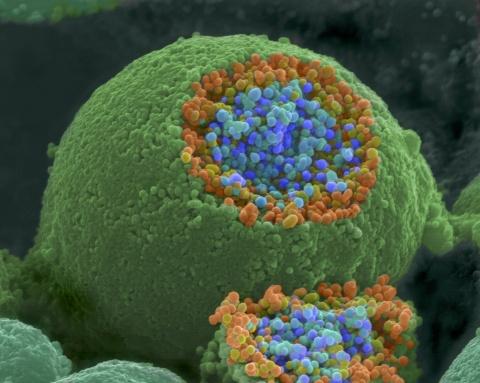
What do a genetic analysis of the intersecting pathways between Alzheimer’s disease and depression, a national prize-winning essay examining the ethics of unionization for physicians, and a systematic review of the literature surrounding a new potential form of therapy for stroke recovery have in common? They’re all subjects of peer-reviewed journal articles written or co-written by members of the Neurology Department published this March.
In our latest “Research Round Up” installment we review each of the 11 articles members of our Department contributed to and provide links to the original studies themselves.
Ethics
- Unionization poses many ethical issues for physicians, with the most important being how to collectively bargain without putting their patients at risk. Resident Danielle Howard, MD, wrote an essay outlining these dilemmas, how they impact vulnerable populations such as residents, and ways that unionization can cause no harm, or even benefit, to patients. This essay was the grand prize winner in the American Medical Association’s Art of Medicine contest. Read it in the AMA’s Journal of Ethics here.
Stroke
- Senior author Wuwei "Wayne" Feng, MD, MS, Carmen Graffagnino, MD, Shreyansh Shah, MD, and colleagues conducted a systematic review of the literature surrounding S-Nitrosoglutathione (GSNO), a nitric oxide donor that may offer neuroprotective and neuro-recovery effects. Their analysis of 6 animal and 4 human studies found GSNO provided significant benefits in both preclinical and clinical studies, indicating that this molecule offers potential as a new form of therapy. Read the full article in Experimental Neurology here.
- Selective serotonin reuptake inhibitors (SSRIs) have a well-established association with bleeding complications but conflicting reports on outcome after stroke. Senior author Michael “Luke” James, MD, Shreyansh Shah, MD, and colleagues evaluated whether pre–intracerebralhemorrhage (ICH) SSRI use increased ICH risk and post-ICH SSRI use improved ICH outcome in a large, multi-ethnic case-control cohort. They found that pre-ICH SSRI use was not associated with increased ICH risk, but post-ICH SSRI use was associated with unfavorable 3-month neurological outcomes after ICH. Read the full article in Stroke.
- Stroke published a letter to the editor by resident Martin Weiss, MD, Shreyansh Shah, MD, and Wuwei “Wayne” Feng, MD wrote a letter discussing a recent article about calculating the hematoma volume of spontaneous intracerebral hemorrhage. Read that article here.
Translational Brain Sciences
- Patients who have late-onset Alzheimer’s disease (LOAD) are more likely to have depression, and depressed patients are also more likely to develop LOAD, suggesting either a shared cause or intersecting pathways between the conditions. Lead authors Michael Lutz, PhD, and Ornit Chiba-Falek, PhD, as well as Julio Barrera, and Daniel Sprague, examined the overlapping genetic signatures underpinning the common phenotypic manifestations and inter-relationship between these two conditions. Read what they found in Translational Psychiatry.
- Senior author Alexandra Badea, PhD, Richard O’Brien, MD, PhD, and colleagues wrote an article in Frontiers in Physics that provides guidelines for new protocols in mouse models of neurological conditions. Read their evaluations of diffusion imaging protocols with various spatial and angular resolutions here.
- A team including Al La Spada, MD, PhD, analyzed the progression of a mouse model of Spinal and bulbar muscular atrophy (SBMA), also known as Kennedy's Disease, from both physiological and histological perspectives. Their analysis uncovered new information about alteration in muscle function in the condition and suggested routes for new muscle-targeted therapies. Read their article in Disease Models and Mechanisms.
- Audrey Dickey, PhD, contributed to a new Journal of Neuroscience article found that inhibition of the dynamin-related protein 1 (Drp1) is neuroprotective. The article also identified Bβ2, a neuron-specific Drp1 activator, which may represent a target for prophylactic neuroprotective therapy in populations at high risk of stroke. Read that article here.
Neurocritical Care
- Elevated systolic blood pressure after successful revascularization via endovascular therapy is a known predictor of poor outcome. However, the optimal SBP goal following EVT is still unknown. Christa Swisher, MD, Shreynash Shah, MD, Ovais Inamullah, MD, and Shareena Rahman, MD, were part of an international multicenter study that compared functional and safety outcomes between different systolic blood pressure goals after EVT with successful revascularization. They found correlations for improved outcomes with lower blood pressure in three designated intervals. Read the full study in Annals of Neurology.
Neuromuscular Disease
- Familial, but not sporadic, forms of amoytrophic lateral sclerosis are associated with a structural variant within the sequestosome 1 gene, according to a new case-control study in Neurology Genetics written by Rick Bedlack, MD, PhD, and colleagues. Read that article here.
Sleep Disorders
- In the latest issue of Neuromuscular Disorders, senior author Andrew Spector, MD, and former sleep fellow Raj Bhui, MD, present a case in which a patient with late-onset Pompe disease was able to discontinue positive airway pressure therapy for his obstructive sleep apnea after treatment with enzyme replacement therapy for his Pompe disease. It is likely that an improvement in muscle tone from the enzyme replacement therapy was sufficient to eliminate his obstructive sleep apnea. Read that article here.
Neuro-Oncology
- Katy Peters, MD, PhD was the senior author of a new review of a promising new therapy for patients with relapsed or refractory primary CNS lymphoma. Read that full review article in the latest issue of CNS Oncology.